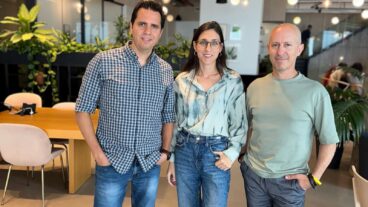Distributed Solar Power Ltd. (DiS.P.) uses semiconductor materials to converts sunlight into energy
A new ISRAEL21c series
The Israeli Energy Alternative
Consumers worldwide are watching with worry as fuel prices steadily climb with no end in sight. The US Department of Energy predicts that by 2025, residential energy consumption will increase by 25% and based upon current trends, the cost of that energy will concurrently rise dramatically.
As fossil fuel resources for petroleum used in fuel processing dwindle, global warming from burning those fossils heats up. Industry experts predict oil production’s peak out in 2007 and the race to find affordable alternative energy solutions sprints forward for scientists, environmentalists and politicians worldwide. Everyone is searching for the proverbial golden ticket: affordable, alternative energy sources to take us into the next century.
“The future belongs to renewable energy,” Brad Collins, Executive Director of the American Solar Energy Society told National Geographic News several years ago. Israel will play an integral part in building that future, particularly in light of a recently proposed Congressional bill granting Israel $120 million over five years for energy research and development. Frontrunners in the alternative arena, Israel’s scientists are at the vanguard of finding innovative yet affordable fuel and energy options.
In the ongoing ISRAEL21c series ‘The Israeli Energy Alternative’, we’ll profile some of the most promising projects and initiatives currently underway in Israel to address growing US and global energy changes.
Here comes the sun
The sun is a practically unlimited source of energy, providing millions of kilowatts of power per hour. Dousing the earth daily with several thousand times more energy than could ever be used, researchers have been tapping into harnessing the sun’s potential since the late 1800?s when French scientist Henri Becquerel discovered the first photovoltaic – or directly harnessed sun energy effect.
Israeli researchers have been working with solar power for decades, from developing solar panels for rooftop installation to heating residential units to creating a giant solar collector for Israel’s Technion Research Institute.
More recently, scientists have entered the realm of photovoltaics, more aggressively seeking to develop widespread affordable and non-polluting uses of solar power.
Specifically looking to compete with grid power giants is Distributed Solar Power Ltd. (DiS.P.) based in northern Israel. Using semiconductor materials, DiS.P. converts sunlight into energy for public, residential, commercial and industrial customers who need clean, high-grade heat and renewable electricity.
“Our system generates both electricity and heat, thus making use of more of the sun’s energy than other systems generating either electricity or heat alone,” company CEO and co-founder Daniel Kaftori, Ph.D told ISRAEL21c.
DiS.P. got its start in 2002 when Kaftori and Tel Aviv University Professor Abraham Kribus began working on the concept of miniature solar concentrating photovoltaics that combine heat and power systems for distributed generation. Upon investigating the technical and economic feasibility of mini systems and concluding their viable potential when used in commercial systems, they formed Di.S.P. in 2004.
An independent company working under the auspices of Yozmot Ha’emek Technological Incubator and utilizing technology licensed from TAU, Di.S.P. received public funding from the Israeli government (via the incubator) and private funding from an Italian energy service provider for their upstart.
Unique in its capability of tracking the sun, Di.S.P.’s mini-solar unit concentrates solar power collected via the tracking device, converting the captured sunlight into electricity and heat. The product selling point is its 75% efficiency due to the dual heat/electric component.
“The process is similar to what we did as children where we used a magnifying glass to burn paper and etch our name onto wood. Here we use a mirror instead of a magnifying glass” to collect and concentrate solar power, says Kaftori. “At the focal point there is high intensity sunlight and heat which makes it possible to utilize the energy at a very high efficiency – much higher than in other solar technologies.”
Unlike stationary system’s, Di.S.P.’s device gets maximum sun benefits because it tracks the sun throughout the day. Ultimately, this translates into efficiency and cost effectiveness. In a detailed analysis of large scale manufacturing costs, Di.S.P. reported a potential 79% decrease in costs when using their system as compared with current average US utility energy costs.
“With good solar conditions, Di.S.P.’s system can generate energy at prices lower than conventional power even without any government incentives or subsidies,” Kaftori reports. “In comparison, without incentives most other solar technology are two to three times more expensive than conventional energy.”
But what happens when solar saturation isn’t optimal, say in a geographically low level sunlight zone such as Ireland? “In essence, we need ‘good’ sunlight. This typically refers to the ‘sunbelt’ – the region between latitudes 34 degrees north and south. The average amount of sunlight is very site-specific and we require good direct solar radiation,” Kaftori explains.
Translated into layman language, the northern United States, Canada, Russia and most of Europe cannot derive full benefit from Di.S.P.’s system. However, explains Dr. H. Avraham Arbib, the deputy chief scientist and Director of R&D at the Ministry of National Infrastructures, this is an issue which can be circumvented.
“In lower-level radiation regions, one would need to exploit diffuse solar radiation as opposed to direct radiation,” Arbib told ISRAEL21c. “Countries like Japan, Germany and others concentrate their efforts on PV (photovoltaics), while countries in the sunbelt are more involved in CST (concentrating solar thermal). The US invests in both technologies because it has states in a wide range of geographic regions.”
“We capture more of the sun’s energy and deliver it to the customer,” Kaftori summarizes. “More advanced technology enables us to convert more of the solar radiation into useful energy and these two factors combine to provide more useful energy to customers over competing systems. Consequently, the price is lower.”
Despite development stage status, Di.S.P. higher-ups say prospective buyers in the US and Israel will begin implementing their technology within the coming year. The company’s target sales strategy will center around the US and according to a spokesperson, testing within Israel has thus far exacted highly positive results.












